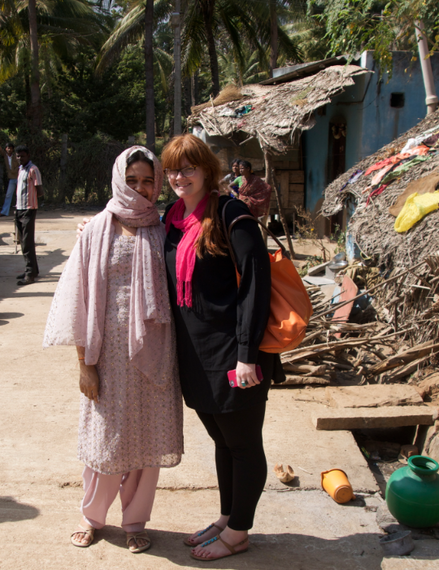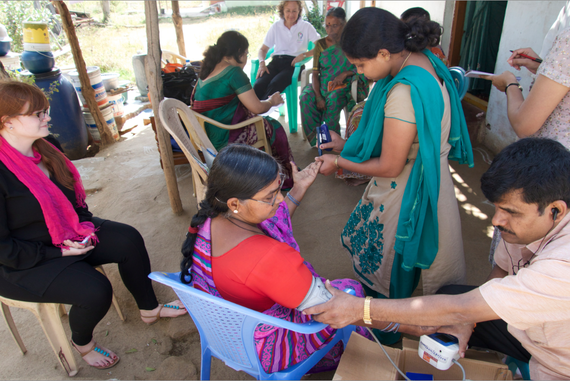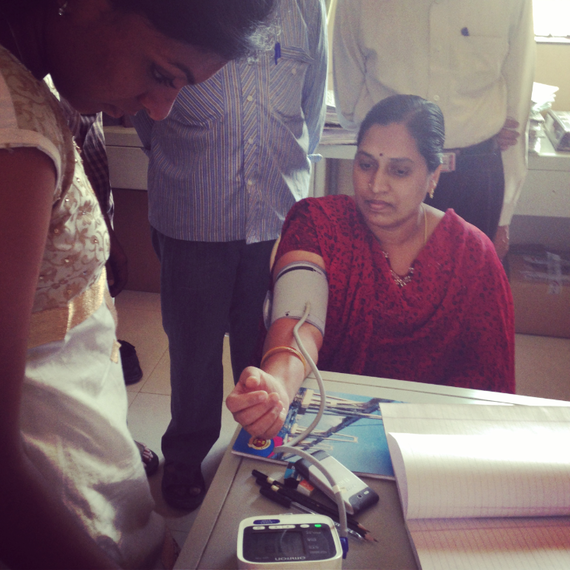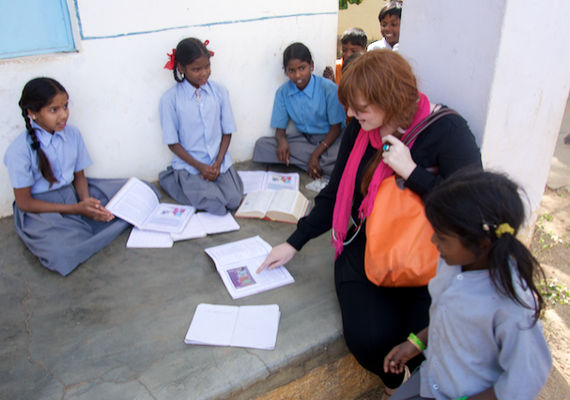"Every day I see children, 10 years old, going blind because their families can't afford insulin. That is what inspires me to fight for them. Who will speak for them if no one shares their story?"
-- Erin Little

Erin Little on right. Photos courtesy of Riva Greenberg.
Eighteen months ago, through a Skype conversation, I met a young American woman named Erin Little. In January, I spent 18 days in Bangalore, India because of her.
Erin has been living inside the Jnana Sanjeevini Medical Center for the poor in Bangalore. She is working tirelessly to better the health of people who live in India's villages and have no access to health care.
What drives an American woman in her 20s to found a social enterprise company, Sucre Blue, dedicated to empowering community health leaders in India -- and live inside a hospital?
Erin is my 19th interview with a change agent in diabetes.
RG: What is Sucre Blue's mission?
EL: We are creating a chronic disease health model to bring affordable access to medical treatment to people who have diabetes, hypertension and cardiovascular disease.
The program is now training dozens of patients and caregivers in rural villages to be health leaders in their communities.
They literally go door to door surveying their villages' residents' health, checking who may have a chronic condition and be in need of treatment.
 Bringing medical care and supplies to a village two hours from Bangalore city.
Bringing medical care and supplies to a village two hours from Bangalore city.
With the second fastest growth of diabetes (IDF Atlas 2013) and 70 percent of the population living in rural villages, India is struggling to provide medical access for chronic conditions.
Sucre Blue operates where the typical community has no doctor, hospital or medical treatment available within a 20-mile radius. Our typical patient household earns less than $2 a day.
RG: What drives you to do this work in India?
EL: I was born in Kansas, raised in Missouri, and most of my relatives are from Louisiana and West Virginia. I grew up with strong roots to small, rural communities. India has a lot of similarities to America's south in terms of hospitality, tradition, family and community. To me, it feels familiar despite the fact I was living in Chicago for almost 10 years before moving to Bombay in 2012.
I've also lived with Type 1 diabetes since the age of 11. I was diagnosed when attending a church camp in southern Missouri. There was no adequate medical care there, so I was life-flighted to the University of Missouri Columbia, where I was hospitalized for almost a month.
There is a phrase in Sankrit, "Vasudhaiva Kutumbakam." It roughly translates into, "The world is a family." For all of India's traditions, which in some way make things here immovable, it is also a place constantly growing and open to change. Here I can have a true impact to make things better, and I can listen more easily to and hear more clearly what my heart is telling me.
 Clinic visit
Clinic visit
RG: How will your project benefit people immediately and long term?
EL: Right now we provide screening, diagnosis, ongoing monitoring and free medicines. And, we are working at prevention through early detection, awareness and education.
Our long-term goal, and what we're focused on at a policy level, is replicating and scaling this social enterprise model at an affordable cost and in a way that it's sustainable and can provide continuity of care. Many of the patients with diabetes, for instance, will need care for complications. So we also want the presence of a clinical institution that actively invests in patients' and the program's success and growth.
It's challenging to understand the value of prevention services. But when you look at the cost difference between putting a diabetes patient, for instance, on dialysis versus managing their condition early through a community based intervention, a country like India can save potentially billions of dollars.
RG: How does an American design a program for local Indian villagers?
EL: This program is designed to be patient-centric and led. Believe it or not, this is where living inside the hospital is a huge advantage. I've lived in India for almost three years, and as someone managing my own Type 1 diabetes in India, I understand how the system works here.
Our partners play a huge role in designing the program to local requirements, gathering feedback and harnessing the power of these communities. We do a lot of listening before we speak.
Regarding culture, recently we had a big debate about whether the village women health leaders should wear white lab jackets when they conduct their door-to-door screenings.
Many were against it, thinking the health worker wouldn't be let into homes; that people would think they were government officers. But the woman who tried it told us many patients came to her thinking she was a nurse which made her job easier!
RG: How are you able to finance this project?
EL: It hasn't been easy. There are relatively few foundations and institutions that do diabetes development work. There's little understanding that non-communicable diseases like diabetes, and getting care and medication, is a human rights issue.
Initially we received an idea-stage grant from Ashoka in a competition called "Transforming Health Systems" supported by Boehringer Ingelheim. I raised some additional funds through friends and family to begin the pilot and I've been financing our work thus far with support from an organization called PAVE.
Just this month Sucre Blue received a large program grant through World Diabetes Foundation that may make it possible to reach 50,000 patients by 2015! That said, we still need support, now more than ever, since the grant doesn't cover costs for myself or salaries.
Toward that end, on April 12, my 28th birthday, we launched a 28-day fundraising campaign (video in train station of campaign launch.) It ends May 10, although of course donations are always welcome. We want to ensure that those who've donated thus far will see the difference they're making, that people who live in poverty will have access to affordable health care.
In India, unlike the West, many patients' diabetes is caused by malnutrition. Less than 50 percent of cases are caused by lifestyle (Public Health Foundation of India Certificate Course in Diabetes Management). I am disappointed so many Westerners think diabetes is a rich man's disease. Every day I see children, 10 years old, going blind because their families can't afford insulin.
I hope and I believe chronic diseases will be the next priority to be addressed in Millenium Development goals, especially as global health challenges like polio and malaria are being eradicated.
RG: What has been surprising thus far?
EL: I used to be surprised when I would hear mothers say they wanted to kill their child who has diabetes, and kill themselves, because they couldn't afford the medicine.
I was surprised to live inside a clinic and not earn a salary. But I am more surprised when people are more afraid for my livelihood than my character, of not doing what I know is right.
Frankly, I've been surprised by what we've achieved in less than a year even when what I have felt called to do seems impossible and have little to nothing materially to gain.
The average Type 1 diabetic spends more than 25 percent of their income on their health (IDF Diabetes Atlas 4th Edition, Economic Costs of Diabetes Report). Many with Type 1 and Type 2 have dealt with extreme poverty caused by this disease.
Whether you are a family battling terminal cancer and foreclosing on your home in Ohio, or a man selling his last cow in the fields of Uttarkhand to manage his diabetes after contracting tuberculosis, Sucre Blue is trying to shift the same paradigm.
RG: What do you hope the future looks like?
EL: Having the capital required to replicate this model for care and give people back their lives without bankrupting them across the developing world.
No patient should feel like a beggar or live without dignity. We do not choose to have a disease, and we have the right to live fully. But in many parts of the world, like here, that luxury doesn't exist.
It has been humbling, and motivating, to live here and do this work. There are days I wonder how I can continue, the other days I know I cannot stop.
RG: What can someone do to help?
EL: Anyone can make a donation donate on our website. We are also actively recruiting board directors and advisors to help us grow and progress our mission, to support those with non-communicable diseases across the world.
We're also in the process of building service trips to our villages. If interested, please contact us at info@sucreblue.org to find out more about coming to Bangalore, India.
I learned while in India, the region has the second highest number of deaths in the world due to diabetes. Erin's work aims to change that, providing care for India's poor, many of whom now travel up to half a day to reach the nearest clinic or doctor.

Riva's latest book, Diabetes Dos & How-Tos, is available in print and Kindle, along with her other books, 50 Diabetes Myths That Can Ruin Your Life and the 50 Diabetes Truths That Can Save It and The ABCs Of Loving Yourself With Diabetes. Riva speaks to patients and health care providers about flourishing with diabetes. Visit her websites DiabetesStories.com and DiabetesbyDesign.com.
